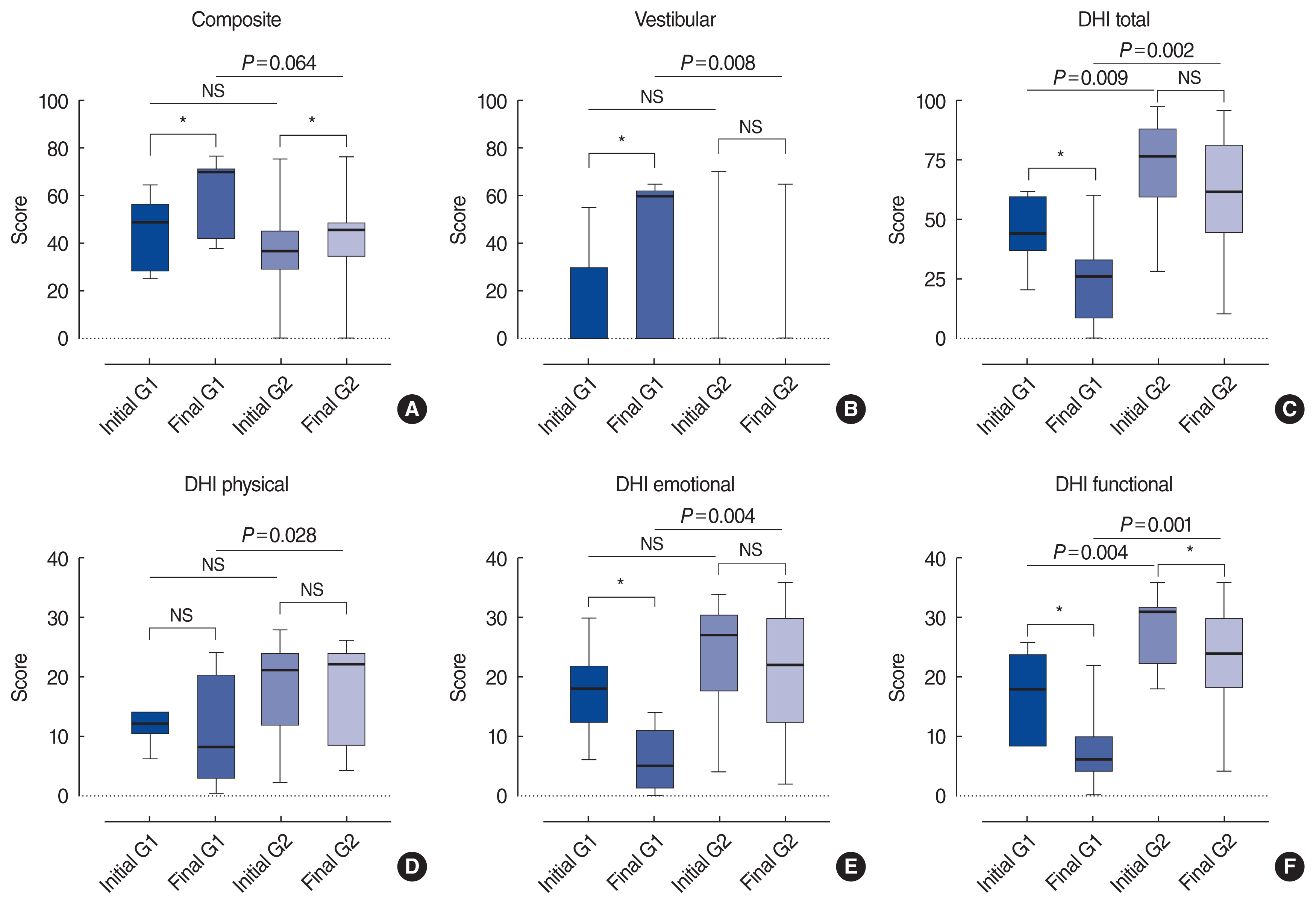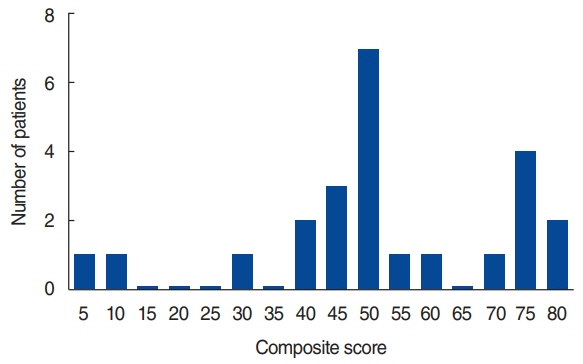Clin Exp Otorhinolaryngol.
2021 May;14(2):192-199. 10.21053/ceo.2020.01739.
Importance of High-Frequency Vestibular Function in the Prognosis of Bilateral Vestibulopathy
- Affiliations
-
- 1Department of Otorhinolaryngology, Yonsei University College of Medicine, Seoul, Korea
- KMID: 2515432
- DOI: http://doi.org/10.21053/ceo.2020.01739
Abstract
Objectives
. The aim of this study was to investigate whether preserved vestibular function in the high-frequency range influences the prognosis of patients with bilateral vestibulopathy (BVP) after vestibular rehabilitation.
Methods
. Twenty-four patients followed up with vestibular rehabilitation were recruited. The enrolled patients were divided into two groups according to the preservation of the high-frequency vestibulo-ocular reflex (VOR) based on the video head impulse test (vHIT). The results of computerized dynamic posturography and the Dizziness Handicap Inventory (DHI) survey collected at baseline and at the 6-month follow-up after vestibular rehabilitation therapy were analyzed.
Results
. Both groups showed significantly increased composite and DHI scores after follow-up with vestibular rehabilitation. The group with preserved high-frequency VOR showed a better composite score (p=0.064) and vestibular score (p= 0.008) than the group with lost high-frequency VOR at the 6-month follow up. The DHI score significantly decreased only in the group with lost high-frequency VOR (p=0.047). Among the three vestibular function tests (caloric test, rotary chair test, and vHIT) used to diagnose BVP, only vHIT showed a significant correlation (p=0.015) with a favorable prognosis (composite score ≥70).
Conclusion
. Better treatment outcomes are likely in patients with BVP with preserved vestibular function in response to high-frequency stimulation, as measured by the vHIT.
Keyword
Figure
Reference
-
1. Zingler VC, Weintz E, Jahn K, Mike A, Huppert D, Rettinger N, et al. Follow-up of vestibular function in bilateral vestibulopathy. J Neurol Neurosurg Psychiatry. 2008; Mar. 79(3):284–8.
Article2. Minor LB, Goldberg JM. Influence of static head position on the horizontal nystagmus evoked by caloric, rotational and optokinetic stimulation in the squirrel monkey. Exp Brain Res. 1990; 82(1):1–13.
Article3. Alhabib SF, Saliba I. Video head impulse test: a review of the literature. Eur Arch Otorhinolaryngol. 2017; Mar. 274(3):1215–22.
Article4. Halmagyi GM, Chen L, MacDougall HG, Weber KP, McGarvie LA, Curthoys IS. The video head impulse test. Front Neurol. 2017; Jun. 9. 8:258.
Article5. Gillespie MB, Minor LB. Prognosis in bilateral vestibular hypofunction. Laryngoscope. 1999; Jan. 109(1):35–41.
Article6. Lacour M, Bernard-Demanze L. Interaction between vestibular compensation mechanisms and vestibular rehabilitation therapy: 10 recommendations for optimal functional recovery. Front Neurol. 2015; Jan. 5:285.
Article7. Minor LB. Gentamicin-induced bilateral vestibular hypofunction. JAMA. 1998; Feb. 279(7):541–4.
Article8. Krebs DE, Gill-Body KM, Riley PO, Parker SW. Double-blind, placebo-controlled trial of rehabilitation for bilateral vestibular hypofunction: preliminary report. Otolaryngol Head Neck Surg. 1993; Oct. 109(4):735–41.
Article9. Porciuncula F, Johnson CC, Glickman LB. The effect of vestibular rehabilitation on adults with bilateral vestibular hypofunction: a systematic review. J Vestib Res. 2012; 22(5–6):283–98.
Article10. Schubert MC, Migliaccio AA, Clendaniel RA, Allak A, Carey JP. Mechanism of dynamic visual acuity recovery with vestibular rehabilitation. Arch Phys Med Rehabil. 2008; Mar. 89(3):500–7.
Article11. Herssens N, Verbecque E, McCrum C, Meijer K, van de Berg R, Saeys W, et al. A systematic review on balance performance in patients with bilateral vestibulopathy. Phys Ther. 2020; Aug. 100(9):1582–94.
Article12. Strupp M, Kim JS, Murofushi T, Straumann D, Jen JC, Rosengren SM, et al. Bilateral vestibulopathy: diagnostic criteria consensus document of the classification Committee of the Barany Society. J Vestib Res. 2017; 27(4):177–89.13. Jeong J, Jung J, Lee JM, Suh MJ, Kwak SH, Kim SH. Effects of saccular function on recovery of subjective dizziness after vestibular rehabilitation. Otol Neurotol. 2017; Aug. 38(7):1017–23.
Article14. Jung J, Suh MJ, Kim SH. Discrepancies between video head impulse and caloric tests in patients with enlarged vestibular aqueduct. Laryngoscope. 2017; Apr. 127(4):921–6.
Article15. Oda DT, Gananca CF. Computerized dynamic posturography in the assessment of body balance in individuals with vestibular dysfunction. Audiol Commun Res. 2015; 20(2):89–95.16. Gera G, Freeman DL, Blackinton MT, Horak FB, King L. Identification of balance deficits in people with Parkinson disease: is the sensory organization test enough? Int J Phys Med Rehabil. 2016; Feb. 4(1):322.
Article17. Demer JL, Oas JG, Baloh RW. Visual-vestibular interaction in humans during active and passive, vertical head movement. J Vestib Res. 1993; Summer. 3(2):101–14.18. Meyer CH, Lasker AG, Robinson DA. The upper limit of human smooth pursuit velocity. Vision Res. 1985; 25(4):561–3.
Article19. Rey-Martinez J, Batuecas-Caletrio A, Matino E, Trinidad-Ruiz G, Altuna X, Perez-Fernandez N. Mathematical methods for measuring the visually enhanced vestibulo-ocular reflex and preliminary results from healthy subjects and patient groups. Front Neurol. 2018; Feb. 9:69.
Article20. Roy FD, Tomlinson RD. Characterization of the vestibulo-ocular reflex evoked by high-velocity movements. Laryngoscope. 2004; Jul. 114(7):1190–3.
Article21. Grossman GE, Leigh RJ, Abel LA, Lanska DJ, Thurston SE. Frequency and velocity of rotational head perturbations during locomotion. Exp Brain Res. 1988; 70(3):470–6.
Article22. Hirasaki E, Moore ST, Raphan T, Cohen B. Effects of walking velocity on vertical head and body movements during locomotion. Exp Brain Res. 1999; Jul. 127(2):117–30.
Article23. Herdman SJ, Schubert MC, Tusa RJ. Role of central preprogramming in dynamic visual acuity with vestibular loss. Arch Otolaryngol Head Neck Surg. 2001; Oct. 127(10):1205–10.
Article24. Heimbrand S, Bronstein AM, Gresty MA, Faldon ME. Optically induced plasticity of the cervico-ocular reflex in patients with bilateral absence of vestibular function. Exp Brain Res. 1996; Dec. 112(3):372–80.
Article



